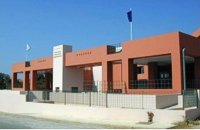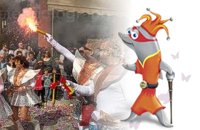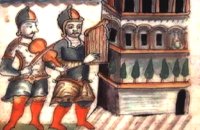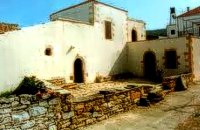interkriti®
YOUR GATEWAY TO CRETE
|
Crete
: People & Traditions
List Grid Map
Found
12
- Showing :
1 - 12
People The population of the island is approximately 630.000 (2005), and over a third of it is found in the three major cities, Iraklion (~150.000), Hania(~50.000) and Rethymnon (~30.000) located on the north coast of the island. Although globalisation, tourism and economic growth have inevitably changed the way of life in Crete, especially in the large urban centres, to a modern and cosmopolitan style, the Cretans still preserve the bonds with their rich folk traditions and cultural heritage. The Cretan dances, Pentozalis, Haniotikos, Pidihtos, Maleviziotikos etc, are still danced at every opportunity and the "madinades" and the "rizitika" songs resound in every celebration. The extra virgin olive oil the legumes and vegetables constitute the base of the local cuisine as did for thousands of years and made the Cretan Diet renowned worldwide for its benefits on longevity and good health. In the countryside, even in our days many old Cretan men and women wear the traditional costume and the Cretan idiom is widely spoken even in the large cities. There is also an exceptional artistic production in traditional sectors such as pottery, embroidery, jewellery etc and of course the very special Cretan Music. The violin (Violi), the lyre (lyra) and the laouto remain the characteristic musical instruments and there are many remarkable new musicians, singers and composers who continue the work of the famous Nikos Xylouris, Thanassis Skordalos, Kostas Moundakis and others. Arts and literature had always played a significant role in the life of the Cretan people, famous painters like El Greco, Michael Damaskinos, writers like Nikos Kazantzakis, poets like Vincenzos Kornaros and Odysseas Elitis, composers like Mikis Theodorakis, Manos Hatzidakis and Giannis Markopoulos are Cretans or of Cretan origin. Today there are many important Cretans with significant contribution in all aspects of the cultural life in Greece. The educational level of the Cretans is relatively high (compared to the other regions of Greece). The educational system consists of the following stages:
Cretans love sports and there is plenty of choices from mountaineering to all kind of watersports to tennis, basketball and footbal which is the most popular. Two Cretan football (soccer) teams compete in the Greek Super Leage (2006-2007 - www.superleaguegreece.net/), OFI (ΟΦΗ: www.ofi.gr/) and Ergotelis (Εγοτέλης :www.ergotelis.gr/). Iraklion has one of the biggest stadia in Greece Pancretan Stadium with a capasity of 26.000 seated. Find related pages...: People & Traditions, Arts & Literature, Sports - Outdoor activities  Voroi, Messara, Iraklion The exhibited objects in the Museum come from all over Crete. These objects show that the folk culture of Crete is characterized by an amalgam of influences in which Minoan (2000-1000 BC), Archaic (1000-500 BC) and Byzantine models prevail, especially in agriculture, stock breeding, pottery and basketry.
 Rethymnon city In winter the town of Rethymno lives in the rhythm of Carnival. Here, the grandest carnival on the island of Crete is organised. Apart from the great parade on Shrove Sunday, a large number of activities complete the framework of the Carnival festivities. The locals devotedly and cheerfully prepare for this season with creativity, they sacrifice their spare time and become young again while rejoicing and celebrating parties almost on a daily basis. More than 4,000 people have worked feverishly for months in order to present their masks and carriages on the great Carnival parade…The following day, on Shrove Monday people from the countryside play a leading part in the festivities. Unique traditions are revived in the villages and everybody is invited to participate in games, street performances and satires as for example “the kidnapping of the bride”, the “Cadi”, the “smudging of people”. These performances in combination with good wine and the music of the lyre are a successful formula for a unique experience. Links: www.carnivalrethymno.com  Agios Nikolaos, Lassithi The Folk Art Museum of Aghios Nikolaos, in collaboration with the "Cultural Society of Eastern Crete", founded in 1978. All the original and important material was generously offered by the Touring Club of Aghios Nikolaos. Since then more objects have been added to the collection. A visit to the Folk Art Museum will help you to become familiar with the sort of work and activities the people of this area had in the old days. The Museum houses a rich and beautiful collection of hundreds of genuine samples of Cretan popular art and mainly hand woven and embroidered pieces, some of which are unique.  Iraklion city, Heraklion In the heart of the city center of Heraklion, opposite the church of Agios Minas, is the Museum of traditional music, instruments, research & documentation with the characteristic title 'Thirathen'. The Museum was founded in 2012 with its headquarters in the historic village of Krousonas, in the Municipality of Malevizi. In December 2023, it opened its doors to the public, in its new space in the center of the city of Heraklion.  masterpiece of the Cretan Renaissance Erotokritos (GR: Ερωτόκριτος) has been characterized as a masterpiece of the Greek language which unites the magic of myth and a deep understanding of everyday life. It expresses the "threefold ideal which is bravery, beauty and wisdom." A work rooted deeply in authentic Greek traditions, humanity, true feeling and pure love for life and freedom. The story takes place in Athens where King Herakles lives with his wife Artemis and their very beautiful daughter Aretousa, with whom the handsome and brave young man Erotokritos, son of the king's advisor, has fallen in love. After many difficulties and trials, the couple is married amidst celebrations and magnificent contests. The world of this work is the ideal Greek world of friendship, pure feelings, authentic Greek traditions. It is the world of the beauty of Athens and Crete which is "the throne of virtue and the river of wisdom." The language of this work is authentic Greek and Cretan, a synthesis and conscious effort of the poet to express lofty human feelings and values with simplicity, directness and truth. The poem was written by Vitsentzos Kornaros (1553-1613/14) a noble Cretan from Sitia with a very strong presence in Greek letters.  Cretan poet of the Greek Renaissance Vitsentzos or Vikentios Kornáros (GR: Βιτσέντζος or Βικέντιος Κορνάρος) or Vincenzo Cornaro (March 29, 1553 – 1613/1614) was a Cretan poet of the Greek Renaissance who wrote the romantic epic poem Erotokritos. He was a leading figure of the Cretan Renaissance. Not many biographical sources exist about Kornaros himself apart from the last verses of Erotokritos. It is believed that he was born to a wealthy family in Trapezonda near Sitia, in 1553, and lived there roughly up to 1590. He then moved to Candia (present Iraklion), where he married to Marietta Zeno. Together they had two daughters named Helen and Katerina. Image Library
 Sitia town The Folklore Museum of Sitia (Siteia, GR: Σητεία) displays items from the 19th and early 20th centuries. It includes some unique embroidery, examples of traditional weaving, wood carvings, local dress and household items, all displayed in an authentic Sitian house setting. Address : 28, Kapetan Sifi Str., 72300 Sitia  Anogia The artistic events, which take place every year in the first week of July at the same place called Fourni and in the Cretan village of Anogia. The poet, songwriter and singer from Anogia, who they call "Loudovikos from Anogia" wants to make the history of the young martyr, who supersedes his fear in love known to the public. And because 1.900 years have passed since the martyrdom of Yakinthos, he decided to honor the Saint of Love and sing together with him of the poetry of love.(www.yakinthia.com)
 Gavalohori, Vamos, Apokoronas The exhibition of the objects takes place according to the contemporary museum conception, with explanatory texts, photographs, plans, models, and is enriched with new exhibits every year. The Museum is divided into seven rooms, according to the following units: The Arched House, Silk, Pottery, Lace-making, Masonry and Stone carving, Church and Woodcarving.
 Seli Ampelou, Lassithi Plateau It is the most significant group of windmills preserved on Crete. It occupies the northern entrance to the Lasithi plateau and is the landmark of the whole area. Today 24 windmills are preserved (out of the original 26), 7 of which extend to the south of the road that enters the plateau while the rest are built to the north of it. All the mills belong to the one-sided type of windmill, that grinds in a standard position, always on the same direction of the wind. Windmills of this type are preserved on Crete and on Carpathos but the Cretan ones are generally more carefully built and more elegant. The group of windmills has been declared a work of art since 1986. The mills belong to individuals and some of them have been restored while others still remain half-ruined. Source: The Hellenic Ministry of Culture 1
|
||
|
| ||
C
O
N
T
E
N
T
S
O
N
T
E
N
T
S


